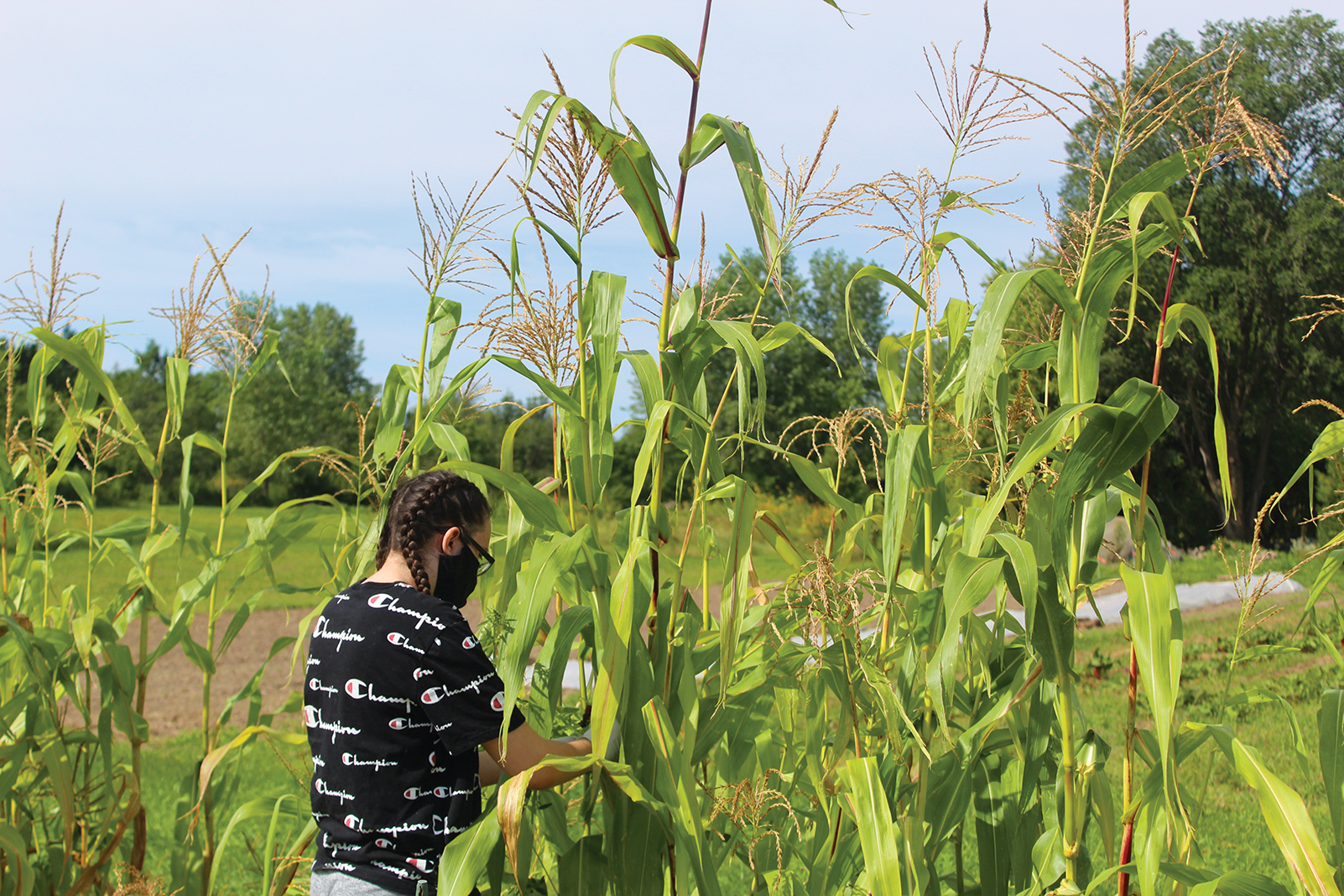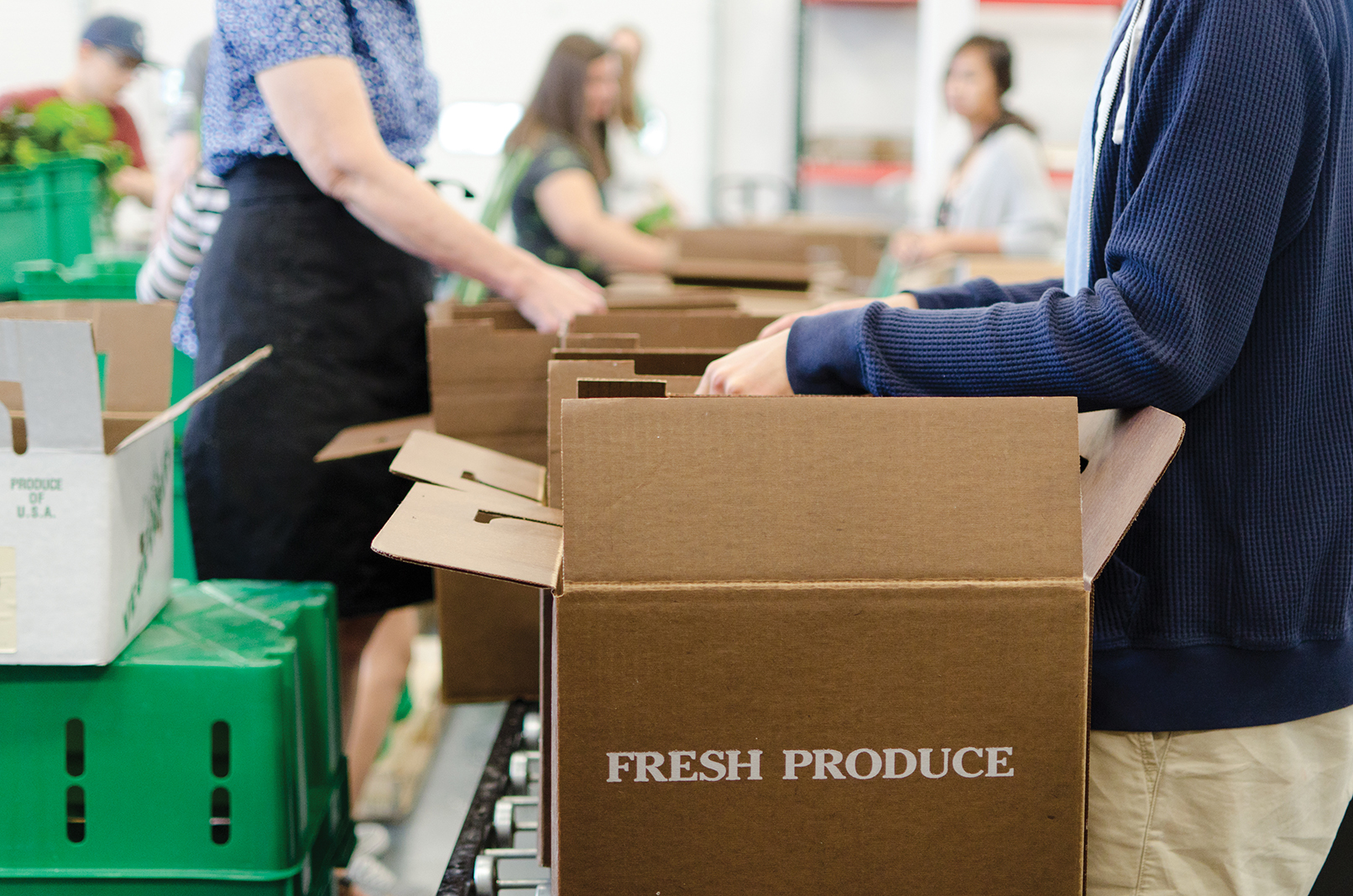
Milan/Adobe
Following an exhausting 2018, Sogn Valley Farm stopped offering shares for its community-supported agriculture (CSA) program.
After three years of boxing up locally grown produce for weekly distribution, head farmer Dana Jokela had decided it was too much to manage. Going into 2020, the Cannon Falls organic and native plant producers planned to spend a season sticking to farmers markets instead. But once the pandemic hit, many markets closed or limited vendor numbers, and Sogn Valley pulled out of farmers markets. Fortunately, there was enough time to re-up on the CSA concept, add a bunch of drop sites, and offer home delivery.
It was the right call: “We over-tripled the size of the CSA we were originally planning to have,” Jokela says.
Sometimes called “farm shares,” CSAs have a huge reach in Minnesota. This year, Minnesota Grown—a Department of Agriculture program connecting Minnesotans with producers of crops and livestock—will represent 80 CSA farms with 160 pickup spots statewide.
Originally started in the United States as subscription-based fresh produce services in the mid-1980s, CSAs now cover everything from cheese (Alemar Cheese Company) to mushrooms (Northwood Mushrooms) to salmon (Sitka Salmon Shares) to flowers (Flower Child Farm). At Springboard for the Arts in St. Paul, CSA stands for Community Supported Art; subscribers get boxes with original works, not produce. In pre-pandemic times, some Wisconsin restaurants even tried a CSA-type model whereby diners, rather than banks, invested upfront.
But as the kinds of CSAs expanded, the overall numbers went down. Throughout the 2010s, many traditional CSA farms say they saw slower sales, lower retention rates, and an overall decline in interest.
That is, until 2020, when COVID-19 came stateside, Minnesota shut down, and life changed entirely. CSAs like Sogn Valley’s suddenly became newly enticing.
“Our final day that we had shares available, we got 35 sign-ups—which is kind of outrageous,” Jokela says. Even on their busiest days, that number tops out at six or eight. “It’s like everyone watched the same TV special on food shortages, and panicked, and decided to buy a share.”

Photo by Alisa Ailts
Seed Money: The CSA Rebirth
In the 1980s, farms across America experienced the worst economic crisis since the Great Depression. More than 49% of the 11,000 Minnesota farmers with Farmers Home Administration loans were in delinquency, and more than 300 farms faced foreclosure. Hundreds of thousands of farms went under.
Cash flow has always been tricky for small farms. The majority of expenses are in the spring (seeds, fertilizer, fuel), but revenue doesn’t come in until after the harvest. It’s common to apply for bridge financing, typically from a bank, and traditionally, farmers assume all of the risk.
In the early ’80s, subscription models that flipped that reliance on loans started to emerge. “We were seeing farmers really, really strapped, financially,” says Dan Guenthner at Common Harvest Farm in Osceola, Wisconsin, just south of Franconia. “Consumers participating by providing some upfront capital for farmers seemed like a really timely idea.”
Founded in 1989, Common Harvest was one of the very first CSA farms to serve the Twin Cities. “There were really only a few of us in that first year,” says Guenthner, who still operates the farm today along with Margaret Pennings and their three children. By 1992, he says, there were about a dozen CSA farms.
In 2012, the Land Stewardship Project, a nonprofit promoting sustainable agriculture, estimated that the metro areas around Minneapolis-St. Paul and Madison, Wisconsin, had the biggest CSA demand outside of New England (where the movement got its start in the U.S.).
But Brian DeVore, who oversees the Land Stewardship Project’s annual CSA directory, says there was recently a bit of a lull. The excitement around CSAs in the late ’90s and early 2000s eventually waned. “I think it was the new, cool thing, and then people weren’t as excited about it,” DeVore says. “There may have been a little saturation of the market.” For the last few years, he says, the farms who list with Land Stewardship Project were starting to have a hard time selling out their shares for the season.

Provided
“Every year it’s been a little tougher, sign-ups are a little slower,” says Nikki Warner, who’s been communications director at the Good Acre, a CSA-like operation in Falcon Heights, for about five years. “Our retention rate has gone down a little bit.”
There are a number of reasons for that decline. Matt Frank at Big River Farms, which runs a CSA program and operates an organic incubator farm near Marine on St. Croix, notes that big-box players like Target and Costco started stocking organic and fair-trade foods. There’s a lot more choice from a consumer standpoint.
CSAs are no longer the only game in town if you want to feel good about the groceries you’re buying—and people just don’t buy groceries like they used to. USDA statistics show that by 2018, the most recent year for which there’s data, the number of meals Americans ate at home had declined to historic lows.
“All you have to do is look at the co-ops, and you realize how prominent the deli now is,” Guenthner says. The bulk-bin areas are shrinking; in many cases, there’s a grab-and-go meal counter.
COVID, of course, disrupted all of that. Suddenly, Target couldn’t keep toilet paper on the shelves, let alone fresh produce. Supply chains and shipping faced unprecedented disruptions. It was tough for shoppers to get to the grocery store at all. Once they did, there were lines to get in and shortages. CSA farms and farmers markets felt trustworthy, and accessible, in a way big retailers no longer did.
“The topic of regional food systems and short supply chains was in the media in a way that it never is,” says Warner. It was getting the attention of people who aren’t traditionally CSA customers, “which I think was really the crux of the CSA problem. Sales were kind of dwindling and slowing down because we’re preaching to the choir.”
Stark images of empty store shelves splashed on the nightly news—but at the same time, there was footage of fields as they were plowed under, thousands of gallons of milk getting dumped, an overabundance of livestock being slaughtered, eggs being smashed. “I think that was pretty horrific for some people,” says DeVore, “and a real learning moment for them about how screwy the system is, where we can have people lined up at food banks on one hand, and on the other we’re dumping food.”
“I think it kicked in: The safest, most reliable way for me to get food is through my local food system, through the farmers that live in and around my community,” says Claire Strader at the Fair Share CSA Coalition, a Wisconsin-based coalition of 40 farms in the Midwest.
The reality of COVID’s seriousness and pandemic-related closures hit in late February and early March—right around the time CSA farms were signing up new members. Restaurants were shuttered by a government mandate, and people weren’t leaving their homes—not even quick-grab Chipotle burrito lunches were an option. CSA pickups created a greater feeling of safety than the store, since most could be outdoors and easily distant. Some even started offering home delivery. “It’s a natural contact-free way to get your food,” Strader says. “That’s not local food broadly, that’s CSA-specific.”
Put it all together, and 2020 was historic for many of the region’s CSA farmers. At Common Harvest, Guenthner says, “We had a wave of interest in the farm like we have never seen before in the second week of March.” Former members called to re-subscribe, and so did friends, neighbors, and relatives. “We ended up taking on more shares than we wanted to.”

Provided
Big River Farms—a Food Group program that offers organic agriculture education to farmers who have historically been underrepresented in farm ownership—saw a 40% increase in CSA membership sales and sold out months earlier than they have historically. Warner says the Good Acre’s farm shares sold out in the first week of April.
The Land Stewardship Project’s directory listed more than 40 farms in 2020. “They sold out faster than they had in years,” DeVore says. “I think almost all of them sold out.”
By the end of April, many Minnesota Grown farmers were closing CSA sign-ups early, even those who had increased the volume of subscriptions. It led Minnesota Grown to survey members to determine where CSA shares were still available and add those farms to a quick list on their website. (Survey feedback included comments like “Filled faster, with lots of brand-new people” and “Significant increase—at least 20%-40%. Plainly related to COVID-19, but not sure why.”)
The challenges commonly associated with CSA shares—getting too much food, or not being able to use everything—were moot. Dana Jokela at Sogn Valley wonders if folks turned to locally grown vegetables to sharpen their immune systems. Plus, people were home all the time, and members commented on filling up their freezers and making soup stock from leftover vegetable scraps. During something of a renaissance in home-cooking techniques, folks were on a first-name basis with their sourdough starter, and regrowing scallions on the windowsill.
“There’s been this emotional tax on all of us … it’s just this heaviness,” Guenthner says. “I think the comfort of something as simple as preparing a meal with whole, fresh ingredients has been one of the most meaningful and uplifting things. It’s been this daily gift that we can give ourselves during the pandemic.”

Provided
Growing Conditions: A Challenging Year
By no means was 2020 an easy year for small farms. CSA sign-ups may have been happening in March and April, but by that point in the growing season, the plans are finalized and the seeds are planted, says Ashley Monk, distribution and operations supervisor at Dream of Wild Health. Arrangements for the Hugo-based farm’s CSA—the Indigenous Food Share—were largely set in place.
Dream of Wild Health was lucky. They could pivot distribution to different buyers than the restaurants they typically supplied. Many of the Indigenous chefs they work with, including Sean Sherman with the Indigenous Food Lab and Brian Yazzie at Gatherings Cafe, also pivoted. Even if their restaurants or businesses were closed, they were able to cook meals for elders in the Native community with the help of COVID funding. “That’s not true for everyone,” Monk adds.
And still, safety concerns loomed large. Farms tried to meet unprecedented interest while being more cautious than ever before. “The communities we serve through the Indigenous Food Share program are at the highest risk for contracting serious health complications and possibly death from COVID,” Monk says.
They prioritized worker health and safety, and it paid off: There were no cases at the farm. But it meant scaling back the size and length of their programs. It also meant shutting down the farm and sending people home if someone got a contact-tracing call from the Minnesota Department of Health. “We experienced some heavy crop loss as a result,” she says.
Most farmers in the Hmong American Farmers Association (HAFA) are at an age—the youngest is 50—that also put them in the most vulnerable population for severe infection. Working a market stand placed them at higher risk.
“Going to the farmers market was challenging for them, especially in the beginning of the season, and so [those farms] relied very heavily on our CSA program,” says Nancy Xiong, HAFA’s capacity building director and CSA program lead for the last two years. For farmers who are used to selling their crops at farmers markets, age and language barriers added additional challenges as some navigated online sales for the first time.

Photo by TJ Turner
Not everyone was able to pivot. For small farms that didn’t do CSAs, business may have dried up entirely. Restaurants closed, and farmers markets that didn’t shut down entirely scaled back the number of vendors. “A lot of our farmers sell produce to schools, and a lot of the farms’ school contracts fell through,” Warner says, regarding Good Acre member farms. As college and corporate campuses shifted to remote learning and working, cafeteria business suffered. Events from music festivals to the Minnesota State Fair were canceled—no way to get produce to those vendors, either. Farmers were left with fields full of crops to harvest, and nowhere to sell once they did.
There was, at the same time, an unprecedented need for hunger relief due to COVID-19. In the Twin Cities, there was additional unmet need in the wake of George Floyd’s killing and the uprising and destruction that followed, which shrank already-limited grocery options in local “food deserts.” Social justice when it came to food insecurity was huge, and new pop-up food banks addressed hunger. “Farm to food shelf was a big thing in the Twin Cities in a way that it has never been before,” Warner says.
Through the new Local Emergency Assistance Farmer Fund (LEAFF), the Good Acre and its partners at Mill City Farmers Market, Lakewinds Food Co-op, the Latino Economic Development Center, the Food Group, and the Hmong American Partnership could purchase up to $7,500 in produce from BIPOC farmers who lost business due to COVID-19 or neighborhood unrest. The purchases went to food banks and nonprofits—including pop-up food shelves and mutual-aid efforts. One of the Good Acre’s biggest produce drop sites last year was the Grease Pit Bike Shop in south Minneapolis, which transformed into a free store over the summer.
Monk at Dream of Wild Health believes that newfound focus on collaboration is one of the most positive things to come out of a truly chaotic year.
“There is so much opportunity for that connectedness,” she says. Working with North Country Food Alliance and the Food Group, Dream of Wild Health was able to donate more than 6,000 pounds of food to community partners last year. “These partnerships were formed out of necessity, but now it’s like, wow, I can’t imagine doing it any other way.”
Next Season’s Promise
It looks like 2021 is another big year for small farms’ CSA programs. Brian DeVore at the Land Stewardship Project says some of the directory’s long-running CSAs emailed him to say that they didn’t even want to seek out new customers because they filled up so fast. “I haven’t seen that before,” he says.
“We have a 75% increase in memberships for 2021, compared to 2020,” says Monk at Dream of Wild Health. They added new Indigenous Food Share options—one in the spring and another in the fall—and this year, they’ll have 88 subscribing families instead of 45. “We sold out in five hours, which has never happened. Everything sold out, and we’re running a waitlist right now.”
At the Good Acre, the retention rate rose 60% from 2020. This year’s shares are projected to sell out by mid-April.
The panic has subsided since last March. Data shows sanitizing groceries isn’t necessary, and shelves are more reliably stocked, but a lot has changed. Culture has shifted around mobility, working from home, restaurant safety, and trips to the grocery store. Pandemic restrictions have eased, but Instagram photos of perfectly baked sourdough loaves still get a lot of likes. And as a second COVID-era growing season crops up, area CSAs are experiencing an explosion in interest.
A relative explosion, that is—this way of eating still isn’t mainstream or accessible to everyone. CSA shares run anywhere from $300 to $500 for a full 18-week share, and home delivery is a relatively new option that expanded during the pandemic. “In order for [CSAs] to grow and be sustainable, we need to follow food justice models,” Monk notes. That means setting up flexible payment plans, accepting Supplemental Nutrition Assistance Program (SNAP) benefits, doing home delivery, growing culturally relevant foods, and ultimately “meeting people where they’re at.”
“Consumer preference only goes so far in a post-pandemic world,” Warner adds. “What we need are legislative food policies that advance sustainable agriculture and strengthen regional food systems. For a truly decentralized, equitable food system—one that really supports small farms and BIPOC farmers, and that protects the environment—we need policies that address inequities in land access.”
And all of that is assuming consumers seek out CSA memberships. Many farmers believe the real test will be 2022, once the U.S. experiences widespread vaccination and the country has more or less opened back up. Will people still feel the connectedness to their local farms?
No one knows what will happen, but DeVore says he’s hopeful. “As one farmer put it to me: ‘It’s great to have this support. I just hope that they stick around after the pandemic.’”

Provided
New to a CSA? Here are some tips for first-timers.
Many farms offer whole and half share boxes. Each week, you’ll receive an evolving selection of fruit and vegetables. It’ll range from common items like tomatoes to more-obscure crops like celeriac root.
- Start with a smaller box—it’s still pretty big—or share a subscription with a friend or neighbor.
- Try to find a box that has a variety of produce. Some, including Big River Farms, even let you rank favorites.
- Think of it as Chopped or Top Chef each time you open a box. Be fully prepared to learn some new techniques and recipes. There are a variety of communities online to help you get started.
- Prepare to freeze and pickle. This is a big one, as many are overwhelmed by the amount of produce and the stress of food waste.
Minnesota CSA resources
These organizations provide information to connect consumers and farmers throughout the region:
- Fair Share CSA Coalition, csacoalition.org
- Land Stewardship Project, landstewardshipproject.org/stewardshipfood/csa
- Minnesota Grown, minnesotagrown.com/csa








